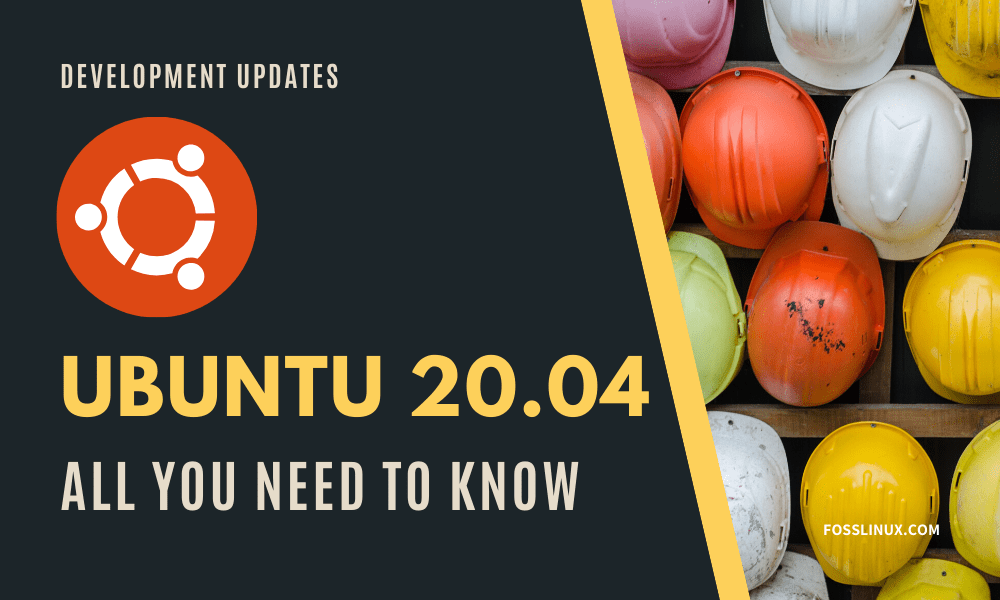The next big thing for Ubuntu is the release of Ubuntu 20.04 LTS, codenamed “Focal Fossa.” The development of this release was officially kickstarted in October 2019. You can find our post here.
Focal Fossa
It is the next long term support (LTS) version after Ubuntu 18.04 LTS, which was launched in 2018 and will get support up to 2023. Going by Canonical’s typical 6-month development cycle, Ubuntu 20.04 LTS is planned for release on April 23, 2020. More details on the Ubuntu 20.04 code name “Focal Fossa” can be found here.
For those new to LTS, these editions will receive OS updates and security fixes for the next five years after release to the public. Applying the same logic on Ubuntu 20.04, you are assured of five years of support, which is up to 2025.
For enterprise clients, they can buy extended support of five more years as an ESM (Extended Maintenace Release).
Ubuntu 20.04 LTS Full Schedule
Canonical makes new Ubuntu release regularly. It enables developers, users, and businesses to plan and make timely schedules with the certainty of access to newer versions.
An exciting thing that we would like to highlight quickly is these releases version numbers are in the format of Year and Month of release (YY.MM). For example, Ubuntu 18.04 was released in April 2018.
Long Term Releases (LTS) are made every two years in April. They are the “enterprise-grade” of Ubuntu and are the most popular and highly utilized. An estimated number of 95% of all Ubuntu installations both in Desktop and Servers are LTS releases.
Canonical also make interim releases of Ubuntu every six months between LTS releases. Examples include Ubuntu 19.04 and Ubuntu 19.10 being the latest, which were published after Ubuntu 18.04 LTS release. Interim releases are not LTS and are only supported for nine months. The advantage of these versions is the inclusion of the latest technologies during development.
Coming back to Ubuntu 20.04 schedule, its launch is targetted on April 23, 2020. Below are the schedules of this release together with important milestones.
⇒ Testing week (optional): January 9, 2020
Testing week is when we have the Beta/Alpha releases. They are always optional. Ubuntu developers encourage a lot of testing during this period, and the releases are made quite faster.
⇒ Feature Freeze: February 27, 2020
No new features will be added to Ubuntu 20.04 LTS. Unless in critical situations. The focus is now on improving the existing features.
⇒ UI Freeze: March 19, 2020
The development of the User Interface stops. No additional features or changes will be made to the UI from this point. If you are a writer, this is the perfect time to take screenshots or screencasts.
⇒ Beta Freeze: April 2, 2020
If you are eager to test the new features in Ubuntu 20.04 LTS, then you can start from this date. However, if you are an end-user and not a developer, it is safer to wait for the final release.
⇒ Kernel Freeze: April 9, 2020
⇒ Final Freeze: April 16, 2020
From this date, no changes, updates, or features will be made to Ubuntu 20.04 LTS. Only rare bug fixes, if any.
⇒ Final release: April 23, 2020
It is the official release date of Ubuntu 20.04 LTS stable release. Both Ubuntu Desktop and Ubuntu server. Users should be able to update to the latest version.
New Features in Ubuntu 20.04
Since Ubuntu 20.04 LTS is a stable release, Canonical main focus is on its stability. Ubuntu 18.04 users might notice a little difference in the user interface and overall performance. However, Ubuntu 19.10 users should not expect a lot of changes.
Let’s take a look at some of the new features, update, and changes to expect in Ubuntu 20.04 LTS.
1. Improved theme
Since the release of Ubuntu 18.04, Yaru has been the default user interface theme for all the latest versions. This theme is what determines items’ colors, size, borders, shadows, and the shape of various elements present on the monitor.
With Ubuntu 19.10 release, Canonical introduced a dark variant of the Yaru theme. In Ubuntu 20.04 LTS, they have made a step further. It comes with three variations that user can switch from “Settings” — Yaru dark, Yaru Light and Yaru standard that falls in between ‘dark and light.’ Read more about this theme here.

Yaru dark, light, standard variations
2. GNOME 3.36
Ubuntu 20.04 makes use of the latest GNOME release (3.36). It will, therefore, incorporate all features present in GNOME 3.36. Let’s take a quick look at some of these GNOME features.
- Improved Cantarell fonts design
- Improved keyboard shortcuts for the image viewer
- Additional preference changes in the GNOME web browser like crashed tabs fixes, opening PDF’s, etc
3. No Amazon Web Launcher
For the last eight years, Ubuntu releases have always come pre-installed with the Amazon launcher that loads in the default web browser ‘Firefox.’ Finally, after years of community backlash, Canonical has decided to remove this launcher in Ubuntu 20.04 LTS.

No Amazon Web Launcher
4. Improved ZFS install support
Ubuntu became the first Linux distribution to introduce of ZFS as root in Ubuntu 19.04 release. Linus Torvalds has expressed his worries concerning this file system. However, ZFS is still prevalent in the market.
It is the only stable file system offering data protection and can survive in the most hostile environment. Unfortunately, ZFS had not entirely accepted by the Ubuntu community due to incompatibilities with CDDL and Linux’s GL license.
5. Linux Kernel 5.4 (not 5.5)
Some of the features in Linux 5.4 include Linux Kernel Lockdown, which aims to ensure security by restricting access to the kernel, exFAT support, and many more.
6. No Python2 support
The last Ubuntu releases have had support for Python2, with some having both Python2 and Python3. Ubuntu 20.04 does not come pre-installed with Python2, and this will be the norm even for upcoming releases. Users and developers will have to adapt and update their code to Python3.
7. New Wallpapers
With every Ubuntu release, Canonical does not seize to excite users with a new set of wallpapers and themes. With the latest version of Ubuntu, users can expect new wallpapers and, of course, a default one for their screen.
These are some of the features to expect in Ubuntu 20.04 LTS. However, this post will be updated as development progresses, and we approach the final release.
Getting Ubuntu 20.04
For anxious developers and users, it’s now possible to download the daily builds for Ubuntu 20.04 for testing purposes. Download them from the Ubuntu CD image server.
Download Ubuntu 20.04 LTS Daily Build
Note that this is still the development stage, and these ISO images should not be deployed in the production end. Test them on your spare computer or via virtualization software like VMware or Virtualbox.
Freshly spun ISO files will be made available to users until the final release on April 23, 2020.
Even though daily builds are mainly meant for testing and debugging, installing them on your computer is an excellent way of flowing with the development cycle. Whenever a new release is made, you can update your system to the latest version until the final release.
Upgrading to Ubuntu 20.04 LTS
Users running Ubuntu 19.04 or Ubuntu 18.04 LTS can upgrade to Ubuntu 20.04 by without a hassle. However, those still using Ubuntu 16.04 LTS will first have to upgrade to Ubuntu 18.04, followed by Ubuntu 19.04 upgrade, and then to Focal Fossa.
That’s it for now regarding the Ubuntu 20.04 development updates. Stay tuned to FOSSLinux!


4 comments
thank you.
God bless
Thanks for writing and sharig this such an informative article.
We are almost there ! Counting the days..
Wow, it’s a triple upgrade if you’re coming from 16.04. Is it still a better idea to wipe and re-install from scratch instead of upgrade > upgrade > upgrade? I’ve separate partitions for my /home users, so there isn’t a need to reformat that.